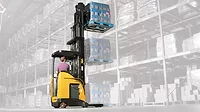Operations
Automated solutions gain foothold in beverage storage
SKU proliferation, shrinking workforce contribute to storage innovations

Pop legend Prince once sang, “You ask me if I love you, it’s automatic.” In the beverage industry, the implementation of automation is not as “automatic” for warehouse operations, but a library of consumer trends are making these operators view automation use as automatic.
Mark Koffarnus, director of major accounts for Yale Materials Handling Corp., Greenville, N.C., explains that SKU proliferation throughout the beverage market actually is part of a larger challenge that spans across the entire warehouse sector.
“Consumer demand for greater selection and availability is on the rise, leaving operations with the task of housing and distributing larger and larger inventory assortments,” he says. “Increasing product assortments are driving beverage warehouse operations to pick more frequently to fulfill these new order profiles — rapidly changing picking and slotting methodologies.”
Dave Williams, vice president of technology solutions at Westfalia Technologies Inc., York, Pa., also highlights the impacts that SKU proliferation is having on beverage warehouses.
“Consumers have become more knowledgeable about their drink choices, forcing manufacturers to continuously introduce new brands and flavors,” he says. “As the beverage industry continues to grow and generate more SKUs, manufacturers and distributors are struggling to find the necessary space for storing these products, while also being able to handle them efficiently. In addition to the added cost of purchasing or producing the new SKUs, SKU proliferation also drives up the costs of customer service, overhead, and decreased output.”
Williams explains that software systems within automated storage and retrieval systems (AS/RS) are providing beverage warehouses with the solutions to help address these growing pains.
“Automated warehouse management systems can correct the negative effects of the SKU proliferation by making the management of your warehouse more efficient, faster and more accurate,” he says. “An automated storage and retrieval system (AS/RS) allows for better management of SKUs in a warehouse. The ability to accommodate for both slow- and fast-moving SKUs is built into an AS/RS design.
“By integrating a warehouse execution system (WES) with the AS/RS, organizations take total control over their inventory, whether it is a slow-moving beverage for the winter months, or a drink that is popular year round,” Williams continues. “The software keeps track of inventory electronically from when products are received through the time they are shipped and/or delivered to the customer. So, you always know where to find the right product for your customer order and you’ll know where to put your best-sellers. Therefore, without having to worry about inventory and maximizing space, manufacturers and distributors can focus on more critical areas, like fulfilling orders.”
Tom Steininger, market development director for Grand Rapids, Mich.-based Dematic, specializing in the food, beverage and manufacturing markets, notes that the categories benefiting from SKU proliferation typically do not have the same distribution velocity as traditional markets. This also is affecting the storage and retrieval aspects of the warehouse.
“The added SKUs have had a major impact on inventory management and storage efficiency, often requiring additional labor to process them. Most new SKUs are slow movers with limited inventory,” he says. “For these, Dematic has implemented mini-load and shuttle-based systems to store items in reserve and present them to pickers as needed for a shift or per day. This technology provides easy access while storing items in a dense and secure space within the warehouse.”
Paul Laman, vice president of food and beverage for Fairfield, N.J.-based DMW&H, also identifies how SKU proliferation impact is stemming from more vanguard beverage categories.
“The increased number of SKUs often shows up in the ‘long tail of SKUs,’ which tends to result in much lower storage density,” he says.
Yet, Laman notes that operations managers are finding ways to maximize storage within warehouses.
“Warehouses are regularly getting taller and are being equipped with higher density storage systems, such as AS/RS, pushback racking and tall narrow aisle racking,” he says. “It helps maximize storage density in warehouses.”
Although automation systems can serve as a solution of SKU proliferation challenges, Gijo George, director of major accounts at Hyster Co., Greenville, N.C., highlights that warehouse operators have additional solutions they can employ.
“While automated storage and retrieval systems sit at the most extreme end of solutions aimed at maximizing storage density, they aren’t the only answer,” he explains. “Less resource-intensive options can still help provide the storage relief that beverage distributors are looking for. One relatively low-impact option is for an operation to re-evaluate its slotting strategy, potentially increasing the number of slots by utilizing equipment that allows access to higher-level pick locations.
“In a similar vein, a heavier impact yet very effective solution to maximize existing warehouse space is re-racking a facility or parts of a facility,” George continues. “Today’s reach trucks are capable of handling 8-foot aisle widths without compromising fast storage and retrieval. A standard aisle is 12 feet wide, but operations can narrow them to fit additional storage aisles in the same space if the right type of lift truck is there to service it.”
Complex layers
Much like the dense layers that make up beverage storage solutions, the factors impacting these operations remains complex. Like many manufacturing markets, warehouse storage also is dealing with the effects of the pandemic.
“COVID-19 is greatly impacting eCommerce and home delivery, as well as alcohol sales,” Westfalia Technologies’ Williams says. “Most of the products in the food and beverage industry are perishable and hence, home delivery services need minimum time to sort and ship orders. With the growing demands of customers, the need for improving speed and accuracy has become crucial in the supply chain. This is driving retailers and wholesalers in the food/beverage sector to adopt automation technologies such as AS/RS, WMS/WCS, layer and case picking solutions and/or pallet flow systems in their warehouse facilities.”
Dematic’s Steininger notes that the pandemic has resulted in some operations implementing SKU rationalization measures, which could remain in place beyond the pandemic.
“In the short term, we are seeing some reduction in SKU numbers to make manufacturing more productive and increase availability of inventory,” he explains. “This may remain a trend for some time and may cause companies to reconsider their storage requirements. With increased production of fewer SKUs, denser systems with higher throughput may be in order. Smaller operation may look to automated guided vehicles (AGVs) for greater flexibility in storing/retrieving pallets over fixed aisle automated storage and retrieval systems.
“Another significant trend is the rapid rise of eCommerce,” Steininger continues. “Major soft drink and snack companies are launching websites to accommodate purchasing of individual items or cases of products. You can now buy soft drinks on Amazon and have them delivered to your house within days. This type of order fulfillment has not been attempted before by distributors and requires totally different storage and picking strategies to meet consumer expectation.”
Although new storage and retrieval protocols have emerged in wake of the pandemic, Yale’s Koffarnus highlights that warehousing operations continue to be challenged by a long-range trend: a shrinking workforce.
“Another warehouse trend that the beverage industry has not been immune from is the workforce shortage,” he says. “In fact, our recent survey found that nearly half of beverage distributors find the lack of skilled workers to be their biggest challenge. Distributors are fighting to secure and retain enough talent from the limited pool of qualified candidates, who are also prone to high turnover. Stretched to piece together the labor needed, it’s become even more imperative that storage solutions – from slotting and picking strategies to facility layout and equipment – are optimized to maximize the productivity of labor that distributors do have on hand.
“In other words, decreasing pick times and increasing throughput,” Koffarnus continues. “Operator productivity can decline over the course of a shift, which is why equipment and workflows designed around operator efficiency and comfort are crucial to preserving productivity, especially as operators are navigating narrower aisles and servicing the higher-level storage locations common in today’s high-density warehouses.”
Hyster’s George echoes similar sentiments regarding the impact that personnel challenges are having on storage solutions within beverage warehouses.
“Distributors face a limited pool of skilled labor and high turnover, and with inexperience among operators comes increased risk of accidents and damage to racks and equipment,” he says. “OSHA estimates that approximately 70 percent of forklift accidents could be avoided through better adherence to standardized training and safety procedures. Beverage distributors tend to be inspected by OSHA more frequently than other industries making safety and record keeping especially critical. As mobile robotics have become increasingly capable, the opportunity to automate not only horizontal transportation but also retrieval and put-away of loads at elevated locations in dense storage configurations has become an attractive prospect for beverage distributors.”
Taking into account how critical capacity and storage density are to beverage warehouses, George notes that efficiency will be just as crucial going forward.
“It’s important that the drive to store more doesn’t cause them to be shortsighted about the need to store and move inventory effectively,” he says. “Order picking accounts for 50 to 65 percent of the typical warehouse’s total operating costs, so managers are well suited to consider all aspects of their storage configuration, including picking paths, slotting strategies and equipment, that can make their inventory movement and management more efficient.”
Meanwhile, Westfalia Technologies’ Williams details the growing influence that software solutions will have on the storage and retrieval market.
“We will continue to see an increase of warehouses and distributers choosing to implement a WES over separate WMS/WCS systems,” he says. “With its modular capability, a WES enables companies of any size to use only the functions they need to handle their warehousing processes. This could range from tracking inventory to fully automating the warehouse with an automated storage and retrieval system (AS/RS). And, instead of purchasing new software when you add new pieces of automation, you simply turn on the WCS features within the WES that you need to manage these new processes.”
Looking for a reprint of this article?
From high-res PDFs to custom plaques, order your copy today!







